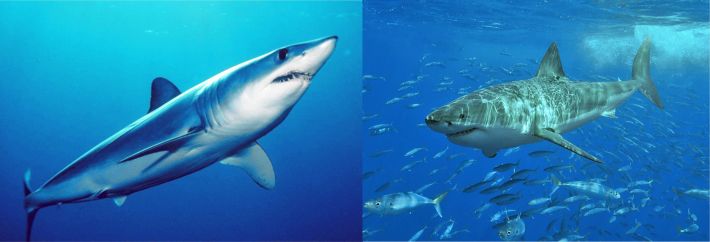Well here at ancient anglers we like to be at the cutting edge of fish research and on that note I will now discuss a paper from last year…yeah. So last year a paper appeared in the journal Palaeontology, entitled “Origin of the White Shark Carcharodon (Lamniformes: Lamnidae) based on recalibration of the Upper Neogene Pisco Formation of Peru”. The reason this paper is so interesting is because it looks to solve the origins of one of the Earth’s marine apex predators the white shark (Carcharodon carcharias) (fig.1)
also known as the “great” white shark. However I suspect the reason it made the headlines is because of the words “white shark” and “Megalodon”, as we all know the general public has always be excited and fascinated my the idea of giant sharks see films such as the critically acclaimed Jaws and the not critically acclaimed Mega shark vs. giant Octopus (fig. 2).
So let’s get into it, what the paper aimed to do as already mentioned is work out the origin of the white shark however the paper also tries to constrain the age of key fossil baring horizons in the Pisco Formation using zircon Uranium–lead (U-Pb) dating and strontium-ratio analysis. So what does this involve? Well U-Pb dating is a radiometric dating method and while I won’t bore you with the ins and outs of dating, put simply as soon as a mineral forms in this case zircon the elements begin to decay and the length of time certain ones take can be used to date rocks to a rather accurate degree. Strontium-ratio analysis is used to investigate tooth enamel in archaeology as well as palaeontology, they use this to date their new species of Carcharodon to around (6-8 Ma).
So yes probably should mention the other purpose of the paper…the new species they describe C. hubbelli seen here (fig.3). Note that it’s only the teeth, jaws and some vertebrae, this is because sharks are not that hard…..well I would not say that to them in person, let me explain.
Sharks belong to a class of animals called Chondrichthyans these critters skeletons are not made of bone instead a softer more flexible tissue called cartilage (we do have cartilage in our bodies located in the discs between our vertebrae and parts of ears and nose). The trouble is that in life cartilage is fantastic for an aquatic as it allows for a super flexible body, but rubbish if you want to be preserved in the fossil record as it’s softer nature means it breakdowns quickly, which is why the majority of shark fossils are represented by teeth, the only “hard parts” on a shark.
The Pisco Formation is located on the coast of Peru and has some of the best Cenozoic marine fossils like elasmobranchs (sharks) teleost’s (the most common bony fish today) Turtles , shore birds and whales anywhere on the planet. So these are excellent deposits to find and try and understand the evolution of the White shark, so let’s try and understand the two schools of thought of how these sharks evolved. The first is that “megatoothed” sharks like Megalodon are part of the Lamnidae and that White sharks are close kin. However the second states that megatoothed sharks are in their own family, the Otodontidae within the Lamniformes (the Lamniformes being the apex ocean going predators of the shark world). What this means is that white sharks are not related to the megatoothed sharks at all.
This latter is the favoured view and the one certainly that the ancient anglers support, the issue with the first theory is that as with most shark work it’s based on teeth and sadly workers in the past have thought that the teeth of White sharks were similar to Megalodon, however it seems they did not take things like not knowing where in the mouth the tooth is located or whether the tooth has pedomorphic (features that are juvenile that an adult retains) characteristics.
So what does this mean for the overall evolution of the White shark, well think of the White shark as a beefed up Mako shark with broad teeth and when looking at them next to each other you can kind of see the similarities (fig. 4). What about the other sharks mentioned in the paper, well these turn out to be what are known as chrono-species, basically one species arose and replaced the other so in the case of the White shark and this paper it is proposed that the progression is Carcharodon hastalis-hubbelli –carcharias (the White shark).
Reference(s)
EHRET, D. J., MACFADDEN, B. J., JONES, D. S., DEVRIES, T. J., FOSTER, D. A. and SALAS-GISMONDI, R. (2012), Origin of the white shark Carcharodon (Lamniformes: Lamnidae) based on recalibration of the Upper Neogene Pisco Formation of Peru. Palaeontology, 55: 1139–1153. doi: 10.1111/j.1475-4983.2012.01201.x
All images taken from google images




